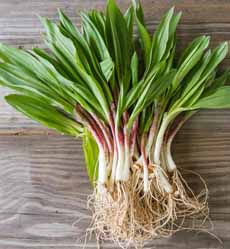
[1] Puréed cauliflower and peas topped with a bouquet of colorful, lightly-steamed vegetables (photo © Maison Kayser).

[2] Fiddlehead ferns (photo by Katharine Pollak | © THE NIBBLE).
|
|
June 17th is National Eat All Your Veggies Day. No matter what the weather is like in your neck of the woods, spring began this morning at 7:02. So, today’s tip is: Cook something that celebrates springtime.
We vote for something colorful. Doesn’t this dish just burst with springtime? You can make it with the ingredients in your fridge! The concept is by Chef Taleb Daher of Maison Kayser, Paris: Puréed cauliflower and peas (you can use any vegetable) topped with a bouquet of color: beets, broccoli florets, carrots, chives, and baby radishes.
Or, prepare a recipe with spring vegetables: low in calories, and high in nutrients. Most of this delectable group are fleeting, available only for a few months a year; so enjoy them while you can. One of the most memorable dishes in our lifetime of fancy eating was a simple spring sauté of asparagus, garlic scapes, morels and nettles.
Artichokes: Spring artichokes are larger, delivering more flesh on each leaf. It couldn’t be easier to steam them and dip the luscious leaves in a vinaigrette or melted butter; we actually enjoy them plain. Check out the different types of artichokes.
Asparagus: Domestic asparagus begins to appear in March; the season runs through June. We can’t get enough of the delicious spears. Here are 12 easy asparagus recipes.
Cardoons: This specialty item, also called artichoke thistle, is part of the same species as the globe artichoke. Not surprisingly, it tastes a lot like artichoke, and was popular among the ancient Greeks, Persians, and Romans. Try braising them in verjus as a side to grilled salmon.
Fava Beans: Fava beans, also known as broad beans and horse beans, are another sign of spring. They originated in ancient Egypt and were the only bean known to Europeans until the discovery of America. Unshelled, they look like lima beans, but have a more buttery texture and slightly bitter, appealingly nutty flavor. Enjoy them as a side, in soups, or in stews. As you may recall, Hannibal Lechter enjoyed his with liver and a nice Chianti.
Fiddleheads: Also called fiddlehead ferns, these young wild ferns are not cultivated but foraged (photo #2). The top unfurls as the fern matures, but when young it resembles the curled ornamentation (scroll) at the top of a violin or other stringed instrument. Fiddleheads have been popular in Northern France since the Middle Ages, and are found in Asian and Native American cuisines. They have an asparagus-like texture and flavor with a hint of nuttiness.
|








